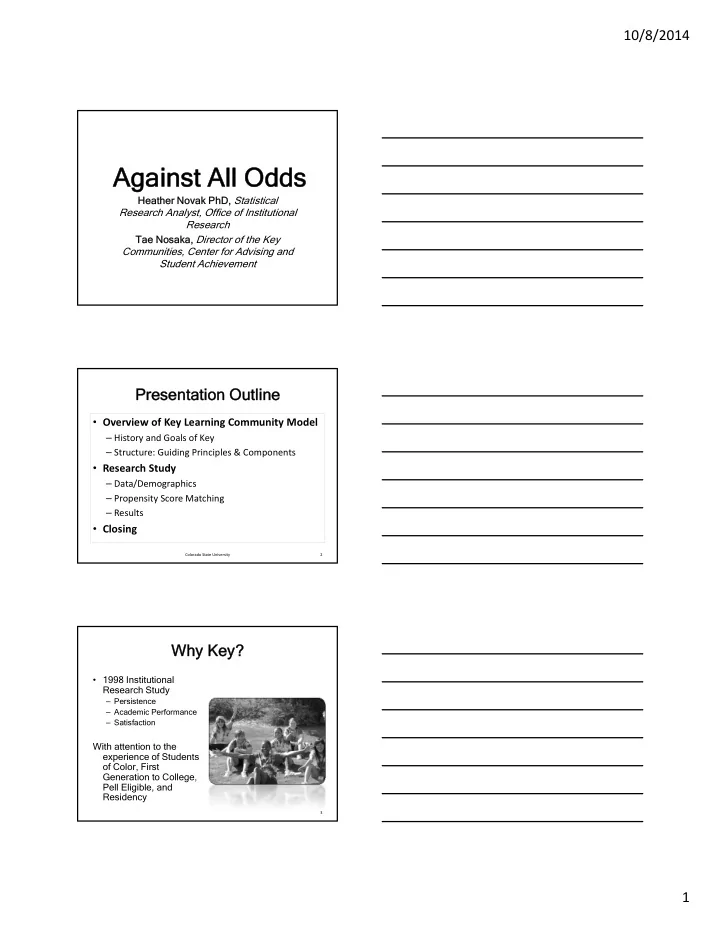

10/8/2014 Against All Against All Odds Odds Heat Heathe her Nova Novak PhD, PhD, Statistical Research Analyst, Office of Institutional Research Tae Nosak Tae Nosaka, Director of the Key Communities, Center for Advising and Student Achievement Presentation Outline Presentation Outline • Overview of Key Learning Community Model – History and Goals of Key – Structure: Guiding Principles & Components • Research Study – Data/Demographics – Propensity Score Matching – Results • Closing Colorado State University 2 Why Key? Why Key? • 1998 Institutional Research Study – Persistence – Academic Performance – Satisfaction With attention to the experience of Students of Color, First Generation to College, Pell Eligible, and Residency 3 1
10/8/2014 4 If students leave, they do so early in their university career Of all students who left (Class Entering in Fall of 2007, measured after 5 years): 52% did so by end of freshman year; 82% by end of sophomore year 60% 52% % of All Departures 50% 40% 30% 30% 20% 10% 7% 7% 4% 0% Adapted from Institutional Research, 1st year 2nd year 3rd year 4th year 5th year Freshman Retention Report, Fall 2012 5 Early connections are most effective First weeks of class Opportunity Pre-enrollment for Application/ Impact Admission Application………………………………Year End 6 2
10/8/2014 Over Overal all Goal Goals of Key of Key Academic performance (GPA) Retention and graduation rates Academic engagement and campus involvement Student satisfaction 7 Guiding Principles Intentionally Maximize Design with Learning Diversity in Opportunities Mind High Expectations, Honest Belief in Feedback: Early Students, and Often Honorary Experience 8 Structure of the Key Communities • 400 first ‐ year students in 4 communities – Key Academic, Key Explore, Key Health Professions, Key Service • Shared values, guiding principles, goals, and overall structure. • Shared residential experience, co ‐ enrollment in course clusters, an orientation program, intentional recruitment, intensive staffing, and traditions. • Each community ranges from 75 ‐ 150 students and is broken down into smaller clusters of 19 students. 9 3
10/8/2014 Structure of the Key Communities Curricular and • Co ‐ enrollment in Course Clusters Co ‐ Curricular • Interdisciplinary Seminars • Dedicated Faculty Engagement Embedded • Guidance and support from high ‐ performing students and professional mentors Feedback and • Early warning and grade feedback • Supplemental Instruction for historically difficult courses Support • Mid ‐ semester progress meetings Building • Designated residence hall community • Key Orientation Community • Traditions Research Research Study Study 1. Does participation in the Key Communities have a positive impact on a student’s likelihood of being retained and graduating? 2. Does the impact of participating in Key vary based on a student’s demographics and academics? Colorado State University 12 4
10/8/2014 Colorado State University 13 Colorado State University 14 Key average index=111 Non ‐ Key average index=114 Colorado State University 15 5
10/8/2014 Colorado State University 16 Colorado State University 17 Includes FA05 & FA06 cohorts Includes FA05, FA06, & FA07 cohorts Includes FA05, FA06, FA07, & FA08 cohorts Colorado State University 18 6
10/8/2014 Propensity Score Matching • Students are NOT randomly assigned Key • Propensity scores: the probability of a student being in Key • Propensity Score Adjusted Data: has one Non ‐ Key student matched to each Key student • Premise: if we match students based on the likelihood to be in Key we approximate random assignment Colorado State University 19 708*.098 = 1991*.0829 = *indicates the proportions are statistically different ( α =.01) Colorado State University 20 Propensity Score Adjusted Data Bottom Quartile ‐ lowest Top Quartile ‐ highest likelihood likelihood of being in Key of being in Key • 116 average index • 106 average index • 11% First Generation • 67% First Generation • 1% Minority • 100% Minority • 1% Pell Recipients • 73% Pell Recipients • 46% Female • 75% Female • 76% Resident students • 87% Resident students Colorado State University 21 7
10/8/2014 Colorado State University 22 Colorado State University 23 Implic licatio ions ns f for P Practic tice Retention and Graduation Rates Considerations of Learning Community Design Scaling Up to Become an Institutional Intervention Collaborations between IR and LC 24 8
10/8/2014 Conclusion • Students with highest propensity to be in Key are the most at ‐ risk for attrition • Most often lost in systems that all too often support the majority group • Key students have beaten the odds with higher retention and graduation rates 25 26 9
Recommend
More recommend